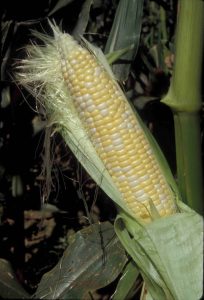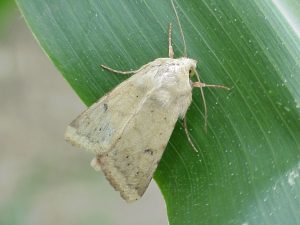Sweet Corn IPM Newsletter No. 9 – August 24, 2018
 Sweet Corn IPM Newsletter No. 9 – August 24, 2018
Sweet Corn IPM Newsletter No. 9 – August 24, 2018
Click on photos to enlarge.
CORN EARWORM PRESSURE REMAINS HIGH
All Late Silking Corn Requires Protection
SITUATION
Weather has continued to be good for both corn growth and pest populations. More hot, humid weather predicted for the next several days will likely keep pest pressure at a high level; so, growers with fresh silking corn should remain vigilant and keep the silks protected until they have dried.
European corn borer: With the exception of fields in Cape Elizabeth and Sabattus, moth activity was low this week. The five moths per week threshold was exceeded at one Cape Elizabeth site and Sabattus. However, both of these sites were also under a spray interval for corn earworm, which should also protect against corn borer. Feeding damage was very light, with no sites over the 15% spray threshold for pre-tassel to silking corn.
Corn earworm: Moths were widespread and in higher numbers in some locations this week, so sprays were recommended for nearly all silking fields. A 6-day spray interval for all silking corn was recommended for Charleston, one Lewiston site, and Sabattus. A 5-day spray interval was recommended for Bowdoinham, Dayton, Levant, Monmouth, Palmyra, Wayne and one Wells site. A 4-day spray interval was recommended for silking fields in Biddeford, Cape Elizabeth, Corinth, Dayton, one Lewiston site, North Berwick, Nobleboro, Oxford, Poland Spring, and one Wells site.
- Corn Earworm Moth; photo by David Handley
- Male Fall Armyworm Moth; photo by David Handley
Fall armyworm: Although we did not catch moths at all locations, counts exceeded the spray threshold for silking corn where we did catch them with only one exception. Fields in Biddeford, Cape Elizabeth, Monmouth, Oxford, Poland Spring, Wayne and Wells were all over the three moths per week spray threshold for silking corn; but all of these sites were also on a recommended spray interval for corn earworm. On younger corn, larval feeding damage was over the 15% control threshold in Cape Elizabeth, Dayton, North Berwick and Oxford.

When Should You Stop Spraying?
When a silking corn field is under a recommended spray interval for corn earworm, we usually recommend that spraying be stopped once the silks have become thoroughly dried and brown. At this stage, corn earworm moths are unlikely to lay eggs on it. However, if earworm pressure is very high (e.g. 91+ moths per week) and/or fall armyworm moths are over threshold (3 or more moths per week), then spraying should probably continue until either the moth counts drop or you reach the required days before harvest (dh) for the product being used.
Birds, etc.: Flocking species of blackbirds are starting to cause damage in cornfields around the state. They are especially attracted to fields where corn has been allowed to get over-mature. Deer, skunks and raccoons have also been troublesome this year. For information on wildlife problems and management options, you may call the USDA Animal and Plant Health Inspection Service (APHIS) office in Augusta at 1.866.487.3297.
Sincerely,
David T. Handley
Vegetable and Small Fruit Specialist
Highmoor Farm, P.O. Box 179, 52 US Route 202, Monmouth, ME 04259, 207.933.2100
UMaine Extension Diagnostic Research Lab, Pest Management Unit, 17 Godfrey Drive, Orono, ME 04473, 1.800.287.0279
| Location | CEW Moths |
ECB Moths |
FAW Moths |
%Feeding Damage |
Recommendations / Comments |
|---|---|---|---|---|---|
| Biddeford | 12 | 0 | 7 | 3% | 4-day spray interval recommended on all silking corn |
| Bowdoinham | 4 | 0 | 0 | 0% | 5-day spray interval recommended on all silking corn |
| Cape Elizabeth I | 30 | 0 | 37% | 4-day spray interval recommended on all silking corn | |
| Cape Elizabeth II | 67 | 29 | 3 | 15% | 4-day spray interval recommended on all silking corn |
| Charleston | 3 | 0 | 0 | 6-day spray interval recommended on all silking corn | |
| Corinth | 12 | 1 | 1 | 4-day spray interval recommended on all silking corn | |
| Dayton | 7 | 0 | 0 | 15% | 5-day spray interval recommended on all silking corn |
| Farmington | 1 | 0 | 0 | 0% | No spray recommended |
| Levant | 4 | 0 | 0 | 5-day spray interval recommended on all silking corn | |
| Lewiston I | 15 | 0 | 0 | 4-day spray interval recommended on all silking corn | |
| Lewiston II | 2 | 0 | 0 | 6-day spray interval recommended on all silking corn | |
| Monmouth | 4 | 8 | 4% | 5-day spray interval recommended on all silking corn | |
| Nobleboro | 11 | 0 | 0 | 4-day spray interval recommended on all silking corn | |
| North Berwick | 23 | 0 | 0 | 16% | 4-day spray interval recommended on all silking corn |
| Oxford | 13 | 0 | 8 | 20% | 4-day spray interval recommended on all silking corn |
| Palmyra | 5 | 3 | 0 | 5-day spray interval recommended on all silking corn | |
| Poland Spring | 31 | 0 | 4 | 0% | 4-day spray interval recommended on all silking corn |
| Sabattus | 2 | 5 | 0 | 6-day spray interval recommended on all silking corn | |
| Wayne | 6 | 0 | 4 | 8% | 5-day spray interval recommended on all silking corn |
| Wells I | 7 | 0 | 0 | 5-day spray interval recommended on all silking corn | |
| Wells II | 23 | 2 | 7 | 4% | 4-day spray interval recommended on all silking corn |
CEW: Corn earworm (Only fresh silking corn should be sprayed for this insect.)
ECB: European corn borer
FAW: Fall armyworm
| Moths caught per week | Moths caught per night | Spray interval |
|---|---|---|
| 0.0 to 1.4 | 0.0 to 0.2 | No spray |
| 1.5 to 3.5 | 0.3 to 0.5 | Spray every 6 days |
| 3.6 to 7.0 | 0.6 to 1.0 | Spray every 5 days |
| 7.1 to 91 | 1.1 to 13.0 | Spray every 4 days |
| More than 91 | More than 13 | Spray every 3 days |
Thresholds apply only to corn with exposed fresh silk. Lengthen spray intervals by one day if maximum daily temperature is less than 80°F.
European Corn Borer Thresholds
Whorl stage: 30% or more of plants scouted show injury.
Pre-tassel-silk: 15% or more of plants scouted show injury.
Silk: 5 or more moths caught in pheromone traps in one week.
IPM Web Pages:
UMaine Cooperative Extension Integrated Pest Management
UMass Amherst Integrated Pest Management
Where brand names or company names are used, it is for the reader’s information. No endorsement is implied nor is any discrimination intended against other products with similar ingredients. Always consult product labels for rates, application instructions and safety precautions. Users of these products assume all associated risks.
The University of Maine is an equal opportunity/affirmative action institution.


